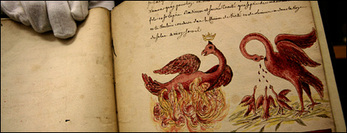
In 2013, life led me to the Science Museum in Wroughton to leaf first-hand through the pages of Nicolas Flamel's alchemy book (pictured) Tresor des Tresors (Treasure of Treasures). This did not take long, as the writing is in French, and with time on my hands after the overview of it, I chose another book from their archives I could read properly, written in English. Fred Hoyle's Action at a Distance in Physics and Cosmology was my selection.
Within the first pages Hoyle's book (co-written with J.V. Narkilar) states that mass is equivalent to a combined interaction between particles (A and B, in the text) and not to the isolated singularity, begging the interesting question of gravitational flux over distance. He speaks of decoupling - selecting data in order to solve problems, easily leading to "the erroneous position of supposing that the physical laws were purely local - although many empirical choices would be needed to make such laws ‘work', just as many empirical choices are indeed made in modern physics." This text was written in 1974, so ‘modern physics' has clearly come some way since then, if not too far.
Thermodynamic irreversibility is explored as an asymmetry which permeates the entire Universe, meaning "we do not have access to the whole class of possible initial states but only to a subclass..." and in further considering this problem he says, "Although the statement of the laws of electromagnetism is fully time-symmetric, all practical applications of the laws are asymmetric. The laws are made to yield asymmetric results by means of an ad-hoc restriction to only time-retarded solutions of Maxwell's equations (‘retarded' meaning based on past ((i.e. historic)) time-wave inputs).
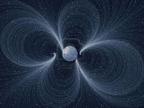
We have only the infinitesimally small human perspective from which to gauge the Universe, and there are curious coincidences involving physicality and Hubble's constant, "when velocity of light C and Planck's constant h are set equal to unity."
"Repulsion," Hoyle says on page 8, "as well as attraction is possible because charges and poles can exist in two species." Gravity can only be explained via large bodies (relative to us) such as planets and stars, but electromagnetism is the reverse, it can only be studied in the lab (at local level). The larger the object (relative to us), the closer it comes to electro-magnetic neutrality.
When we reach page 14, "The retarded solution appeals to our intuition because it conforms to the usual idea of causality" (e.g. entropy and the flow of time) with "events arising subject to the effect of motion/cause." The advanced solution, on the other hand, proposes that effects arise prior to the events which cause them, and there is no doubt that in undertaking the journey of life we see - or rather sense - this happening. This is in keeping, purports Hoyle, with the human tendency to anticipate and cause an effect by so doing. "In order to be consistent with causality," he writes, "we choose the boundary condition," leading the equation to equate to the path of least resistance for the mind.
But, Hoyle argues, with so many other options on the table, "why does Nature always select the retarded one?" Well, we might question, does she? How do we know, merrily choosing paths of least resistance in following clues to a conclusion, that Nature does not access many other sums over the histories of what she encounters? Who is to say that we see the full picture, when clearly we are tempted to gravitate towards the bonds of local, easily interpreted solutions?
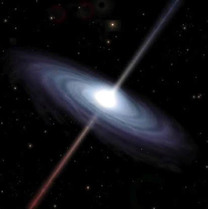
Hoyle offers two metaphorical systems of attraction on page 21, one using elastic string drawing two particles together and the other using gravity. Elasticity ceases to be an attracting force when the string has reached its natural length, while gravity continues to attract until the particles or objects collide. According to the equations, elasticity is a "positive definite and is characteristic of most systems in the world." The gravitational equation is negative, and reverts to infinity. Hoyle notes that "in both cases the system seeks to attain the position of minimum potential energy," which is exactly what electrons do within the confines of the atom. Consider also the patterns we follow through changes in our free-radical (non-genetic) relationships.
Page 23 leads us to black holes, where time, apparently, equals Pi, and "not only does the body fall into a point, but spacetime itself becomes singular." Light is the definitive measurement of a black hole's behaviour and the event horizon is determined as the space from which even light cannot escape (my emphasis). Hoyle points out that classical interpretation of the singularity issue "excludes the experience of the freely falling observer. A more satisfactory resolution would require spacetime to be non-singular everywhere."
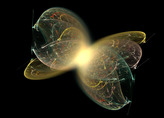
"That a theory with advanced and retarded signals can be made to work in the real world was first realised by Wheeler and Feynman. They pointed out that "in the real world one has to take into account a ‘response of the universe'. How the universe enters the argument in a crucial way can then be seen as follows..." by which time we're on page 32 and he sums charges over distance, proving the validity of instantaneous reactions as "we must therefore take into account the reactions of all other charges...in the universe."
While he surmises on pages 47 and 48 that "the electromagnetic field is formally symmetric," Hoyle opens Chapter 4 by stating, "Although success in the classical domain is necessary for any physical theory, it is not sufficient. Nature, as we understand it today, is quantum in character." Thereby safely inferring that so are we, quantum in character, and in accord with the laws of Nature, we behave in modus operandii as quantum units do.
With insufficient time to continue reading, notes were terminated at that point in 2013, and rediscovered today while on another mission, whereupon the advanced/retarded nature of timing in my personal world brought them here to you now.
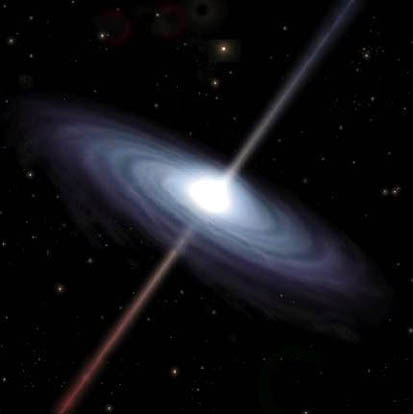
 RSS Feed
RSS Feed
